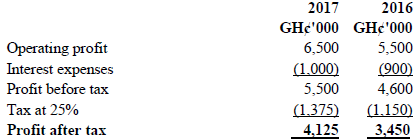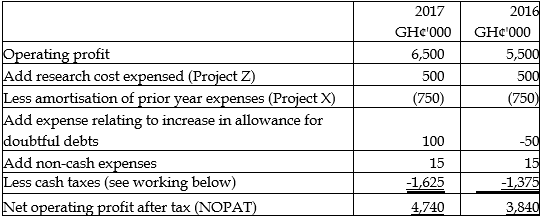Jabesh Company limited inc ome statements for the years 2016 and 2017 are provided below:

The company directors at a meeting argued that the use of Economic Value Added as a measure of corporate performance is more relevant to current developments in financial markets and agreed to employ it in assessing its performance for year 2017 and 2016.
Additional information is as follows:
i) The allowance for doubtful debts was GH¢300,000 at 1 January 2016, GH¢250,000 at 31 December 2016 and GH¢350,000 at 31 December 2017.
ii) Research and development costs of GH¢500,000 were incurred during each of the years 2016 and 2017 on Project Z. These costs were expensed in the income statement, as they did not meet the requirements of financial reporting standards for capitalization. Project Z is not complete yet.
iii) At the end of 2015, the company had completed another research and development project, Project X. Total expenditure on this project had been GH¢1,500,000, none of which had been capitalised in the financial statements. The product developed by Project X went on sale on 1 January 2016, and the product was a great success. The product’s lifecycle was only two years, so no further sales of the product are expected after 31 December 2017.
iv) The company incurred non-cash expenses of GH¢15,000 in both years.
v) Capital employed (equity plus debt) per the statement of financial position was GH¢33,500 at 1 January 2016, and GH¢37,000 at 1 January 2017.
vi) The pre-tax cost of debt was 5% in each year. The estimated cost of equity was 12% in 2016 and 14% in 2017. The rate of corporate tax was 25% during both years.
vii) The company’s capital structure was 60% equity and 40% debt.
viii) There was no provision for deferred tax.
Required:
Calculate the Net Operating Profit after tax (NOPAT) for the years ended 2017 and 2016. (6 marks)
View Solution

WORKINGS:

